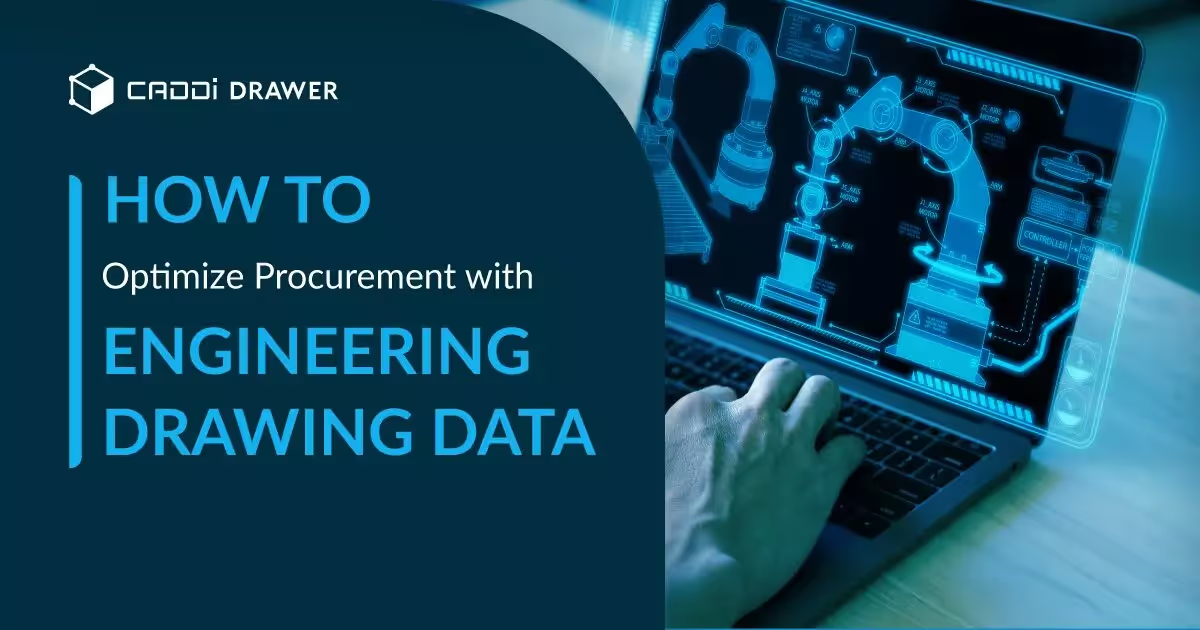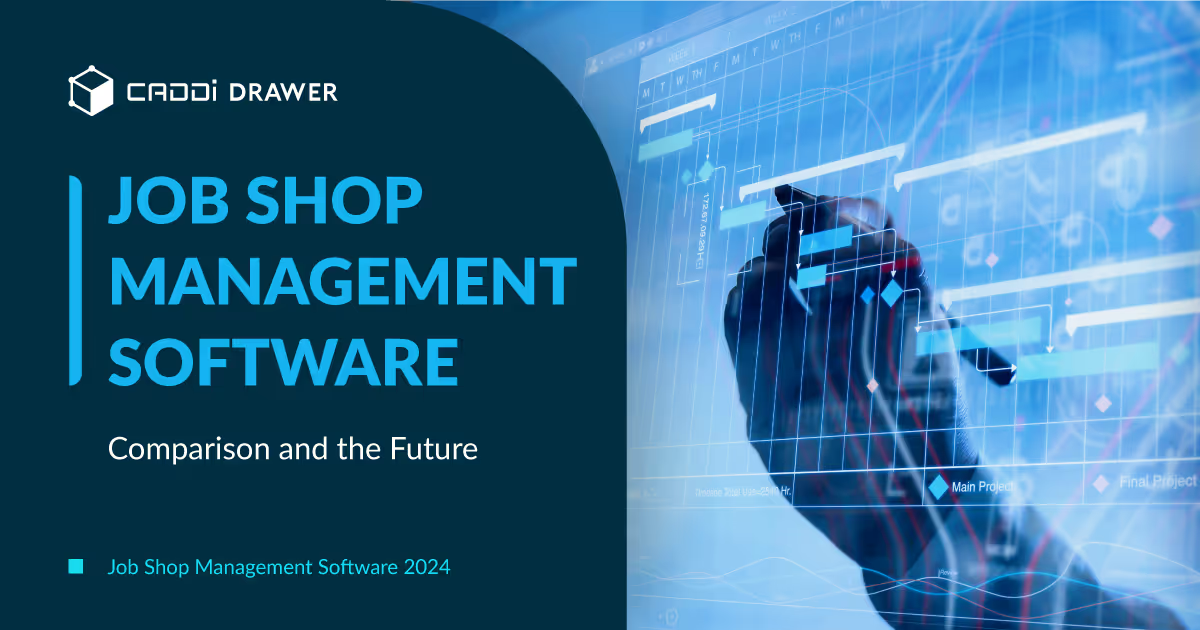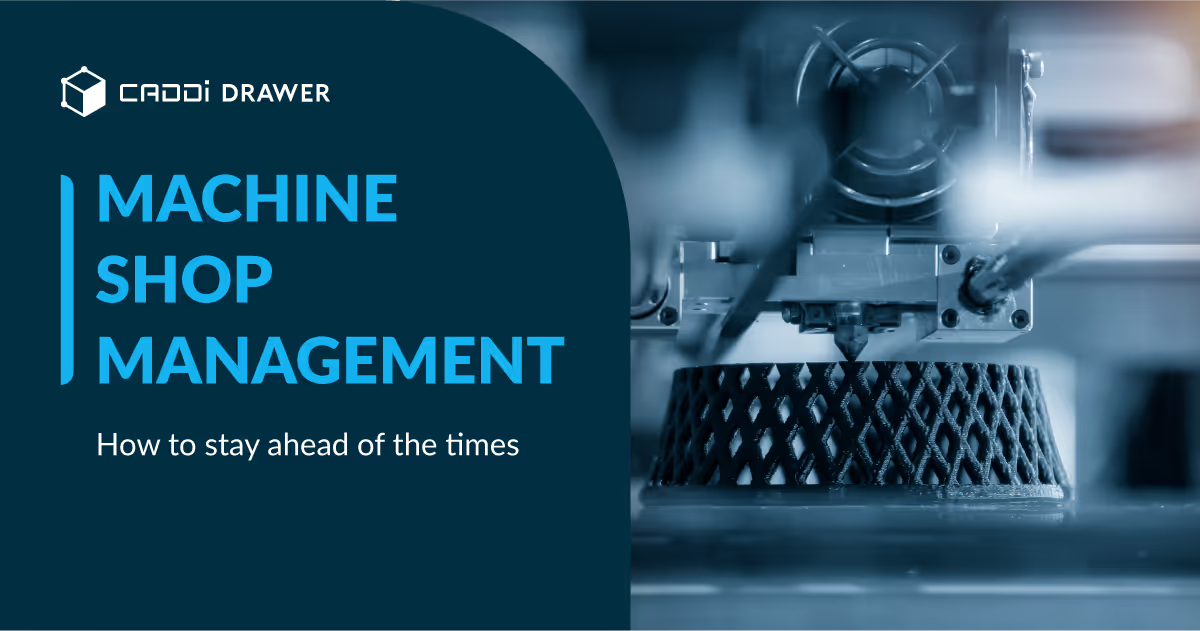How to Optimize Procurement with Engineering Drawing Data

Table of Contents

The Challenge of Traditional Procurement Data
Traditional procurement data sources like ERP systems, supplier records, and inventory databases often fall short in providing comprehensive insights as below.
- Incomplete data – Not all relevant procurement data gets captured in these systems. Important details may be stored in emails, spreadsheets, or paper documents separate from core databases. This results in blindspots in analysis.
- Data inconsistencies – Since procurement data comes from multiple sources, there are often inconsistencies in categorization, naming conventions, units of measure, and more. Resolving these is time-consuming.
- Inaccurate data – Errors can creep in from manual data entry across different systems. Typos, duplicates, and outdated information reduce data accuracy.
- Siloed data – Cross-functional data is difficult to connect. There may be limited visibility between engineering, procurement, finance, and other departments.
These limitations result in procurement analytics that is incompleted, fragmented, and unreliable. Key insights get missed, leading to suboptimal spending decisions.
The Potential of Engineering Drawing Data
Engineering drawings contain a wealth of detailed product data and specifications that are often overlooked in procurement processes. By tapping into this rich data source, organizations can gain powerful insights to optimize purchasing and improve bottom lines.
Drawings include precise materials specifications, dimensional data, tolerance requirements, surface finish designations, and other technical details for manufactured parts and assemblies. The visualization of drawing data in structured formats allows buyers to understand exact product needs for more informed sourcing. This information provides invaluable accuracy for procurement teams to source components that perfectly match design requirements.
Extracting data from drawings also enables advanced analytics of engineering requirements. Statistical analysis of materials usage, cost driver metrics, supplier performance, and other trends can help procurement managers negotiate better contracts, consolidate purchases for volume discounts, and streamline inventories.
The level of detail in engineering drawings simply cannot be captured through traditional procurement data sources like purchase orders and invoices. Unlocking the untapped potential in legacy drawing archives represents a massive opportunity to strengthen procurement intelligence.
Integrating and Analyzing Drawing Data
Drawing data, however, is often siloed and disconnected. You need to build a foundation where drawing data is linked to ERP and procurement systems across the enterprise to identify savings opportunities and reduce maverick buying.
Advanced technologies like AI and machine learning (ML) are key to harnessing the full potential of drawing data. AI can automate the extraction of metadata from drawings at scale. This includes information on parts, materials, dimensions, and more.
ML algorithms can then analyze these extracted datasets to spot trends and patterns. This may reveal inefficiencies in procurement spend or design reuse. ML can also enable predictive analytics, forecasting future materials and parts needs.
Integrating disconnected drawing data enables holistic analysis with AI and ML. This gives procurement leaders the actionable insights needed to optimize operations. Drawing data integration culminates in a digital thread that connects design, procurement, and manufacturing.
Optimizing Procurement with Drawing Insights
Engineering drawings contain a wealth of data that can empower procurement teams to optimize spending and processes when leveraged properly. Here are some of the ways drawing data can lead to procurement improvements:
Improved Spend Analysis
- Analyzing drawing data helps identify the specific parts, materials, and services being purchased. This granular understanding improves spend visibility.
- Data from drawings enables a digital bill of materials for tracking quantities and costs. This enhances spend analytics.
- Drawing details reveal specifications and requirements for purchased items. This knowledge strengthens strategic sourcing decisions.
Stronger Supplier Negotiations
- With detailed specifications from drawings, procurement can consolidate spend and negotiate better contracts.
- Drawing data aids in supplier qualification based on production capabilities required.
- Quantities and costs from drawings support fact-based negotiations with suppliers.
Increased Design Standardization
- Drawing analysis uncovers commonalities between product designs that allow part standardization.
- Identifying interchangeable parts through drawings enables procurement savings.
- Design optimizations to maximize standard components can be identified from drawing data.
- Drawings indicate where custom parts could be replaced by standardized options.
Implementing a Drawing Data Strategy
To implement an effective drawing data strategy and drive procurement optimization, organizations need strong data governance, change management, and executive sponsorship.
Data Governance
A clearly defined data governance model is essential to get value from engineering drawings. This includes data policies, standards, and accountability for data quality.
Procurement teams should partner with engineering and IT to:
- Establish data ownership – Who is accountable for which drawing data attributes?
- Set policies for metadata, file formats, storage, security, and retention
- Define standards for data inputs, taxonomy, and integration
- Monitor data quality via audits and KPIs
- Create feedback loops to continuously improve data practices
Change Management
Extracting value from drawings requires changes to existing workflows and mindsets. A change management plan can ease this transition by:
- Communicating the benefits of data-driven procurement
- Providing training on new drawing practices and systems
- Involving change champions from engineering and procurement
- Celebrating small wins and milestones
- Monitoring adoption and addressing resistance
Executive Sponsorship
Executive sponsors give drawing data initiatives necessary priority and resources. Ideally, the CPO and engineering lead jointly sponsor the strategy to signal cross-functional alignment. Executive sponsors should:
- Allocate budget for technology and talent
- Set expectations for participation
- Review progress at steering committee meetings
- Remove roadblocks
- Link data success to incentives
How CADDi Drawer can help by extracting and structuring drawing data
CADDi Drawer empowers procurement teams to optimize their processes by unlocking the untapped potential of engineering drawing data. The platform automatically extracts all relevant information from drawings, including dimensions, text, and shapes, making even handwritten drawings from decades ago searchable and comparable.
.avif)
By connecting this extracted data with quotation and supply-chain information from CSV files and ERP systems, Drawer creates a comprehensive, structured dataset that procurement professionals can leverage for strategic decision-making. The platform’s powerful keyword and similarity search capabilities enable users to quickly identify similar parts across their entire historical drawing archive, revealing opportunities for supplier consolidation, price negotiation, value analysis and engineering (VAVE) initiatives, and strategic sourcing.
With CADDi Drawer, procurement teams can identify the best suppliers based on historical pricing and drawing data, consolidate orders to increase volume and reduce costs, and pinpoint reference prices that assist RFQ processes. By integrating disconnected drawing data and enabling advanced analytics, CADDi Drawer provides the actionable insights procurement leaders need to optimize their operations, reduce maverick buying, and improve their bottom line.
The Challenge of Traditional Procurement Data
Traditional procurement data sources like ERP systems, supplier records, and inventory databases often fall short in providing comprehensive insights as below.
- Incomplete data – Not all relevant procurement data gets captured in these systems. Important details may be stored in emails, spreadsheets, or paper documents separate from core databases. This results in blindspots in analysis.
- Data inconsistencies – Since procurement data comes from multiple sources, there are often inconsistencies in categorization, naming conventions, units of measure, and more. Resolving these is time-consuming.
- Inaccurate data – Errors can creep in from manual data entry across different systems. Typos, duplicates, and outdated information reduce data accuracy.
- Siloed data – Cross-functional data is difficult to connect. There may be limited visibility between engineering, procurement, finance, and other departments.
These limitations result in procurement analytics that is incompleted, fragmented, and unreliable. Key insights get missed, leading to suboptimal spending decisions.
The Potential of Engineering Drawing Data
Engineering drawings contain a wealth of detailed product data and specifications that are often overlooked in procurement processes. By tapping into this rich data source, organizations can gain powerful insights to optimize purchasing and improve bottom lines.
Drawings include precise materials specifications, dimensional data, tolerance requirements, surface finish designations, and other technical details for manufactured parts and assemblies. The visualization of drawing data in structured formats allows buyers to understand exact product needs for more informed sourcing. This information provides invaluable accuracy for procurement teams to source components that perfectly match design requirements.
Extracting data from drawings also enables advanced analytics of engineering requirements. Statistical analysis of materials usage, cost driver metrics, supplier performance, and other trends can help procurement managers negotiate better contracts, consolidate purchases for volume discounts, and streamline inventories.
The level of detail in engineering drawings simply cannot be captured through traditional procurement data sources like purchase orders and invoices. Unlocking the untapped potential in legacy drawing archives represents a massive opportunity to strengthen procurement intelligence.
Integrating and Analyzing Drawing Data
Drawing data, however, is often siloed and disconnected. You need to build a foundation where drawing data is linked to ERP and procurement systems across the enterprise to identify savings opportunities and reduce maverick buying.
Advanced technologies like AI and machine learning (ML) are key to harnessing the full potential of drawing data. AI can automate the extraction of metadata from drawings at scale. This includes information on parts, materials, dimensions, and more.
ML algorithms can then analyze these extracted datasets to spot trends and patterns. This may reveal inefficiencies in procurement spend or design reuse. ML can also enable predictive analytics, forecasting future materials and parts needs.
Integrating disconnected drawing data enables holistic analysis with AI and ML. This gives procurement leaders the actionable insights needed to optimize operations. Drawing data integration culminates in a digital thread that connects design, procurement, and manufacturing.
Optimizing Procurement with Drawing Insights
Engineering drawings contain a wealth of data that can empower procurement teams to optimize spending and processes when leveraged properly. Here are some of the ways drawing data can lead to procurement improvements:
Improved Spend Analysis
- Analyzing drawing data helps identify the specific parts, materials, and services being purchased. This granular understanding improves spend visibility.
- Data from drawings enables a digital bill of materials for tracking quantities and costs. This enhances spend analytics.
- Drawing details reveal specifications and requirements for purchased items. This knowledge strengthens strategic sourcing decisions.
Stronger Supplier Negotiations
- With detailed specifications from drawings, procurement can consolidate spend and negotiate better contracts.
- Drawing data aids in supplier qualification based on production capabilities required.
- Quantities and costs from drawings support fact-based negotiations with suppliers.
Increased Design Standardization
- Drawing analysis uncovers commonalities between product designs that allow part standardization.
- Identifying interchangeable parts through drawings enables procurement savings.
- Design optimizations to maximize standard components can be identified from drawing data.
- Drawings indicate where custom parts could be replaced by standardized options.
Implementing a Drawing Data Strategy
To implement an effective drawing data strategy and drive procurement optimization, organizations need strong data governance, change management, and executive sponsorship.
Data Governance
A clearly defined data governance model is essential to get value from engineering drawings. This includes data policies, standards, and accountability for data quality.
Procurement teams should partner with engineering and IT to:
- Establish data ownership – Who is accountable for which drawing data attributes?
- Set policies for metadata, file formats, storage, security, and retention
- Define standards for data inputs, taxonomy, and integration
- Monitor data quality via audits and KPIs
- Create feedback loops to continuously improve data practices
Change Management
Extracting value from drawings requires changes to existing workflows and mindsets. A change management plan can ease this transition by:
- Communicating the benefits of data-driven procurement
- Providing training on new drawing practices and systems
- Involving change champions from engineering and procurement
- Celebrating small wins and milestones
- Monitoring adoption and addressing resistance
Executive Sponsorship
Executive sponsors give drawing data initiatives necessary priority and resources. Ideally, the CPO and engineering lead jointly sponsor the strategy to signal cross-functional alignment. Executive sponsors should:
- Allocate budget for technology and talent
- Set expectations for participation
- Review progress at steering committee meetings
- Remove roadblocks
- Link data success to incentives
How CADDi Drawer can help by extracting and structuring drawing data
CADDi Drawer empowers procurement teams to optimize their processes by unlocking the untapped potential of engineering drawing data. The platform automatically extracts all relevant information from drawings, including dimensions, text, and shapes, making even handwritten drawings from decades ago searchable and comparable.
.avif)
By connecting this extracted data with quotation and supply-chain information from CSV files and ERP systems, Drawer creates a comprehensive, structured dataset that procurement professionals can leverage for strategic decision-making. The platform’s powerful keyword and similarity search capabilities enable users to quickly identify similar parts across their entire historical drawing archive, revealing opportunities for supplier consolidation, price negotiation, value analysis and engineering (VAVE) initiatives, and strategic sourcing.
With CADDi Drawer, procurement teams can identify the best suppliers based on historical pricing and drawing data, consolidate orders to increase volume and reduce costs, and pinpoint reference prices that assist RFQ processes. By integrating disconnected drawing data and enabling advanced analytics, CADDi Drawer provides the actionable insights procurement leaders need to optimize their operations, reduce maverick buying, and improve their bottom line.
Ready to see CADDi Drawer in action? Get a personalized demo.
Subscribe to our Blog!
Related Resources












.svg)



.svg)
.svg)
.svg)


